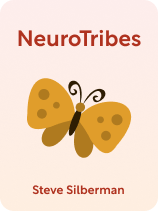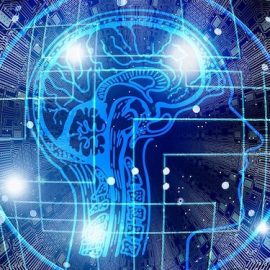

This article is an excerpt from the Shortform book guide to "NeuroTribes" by Steve Silberman. Shortform has the world's best summaries and analyses of books you should be reading.
Like this article? Sign up for a free trial here.
What are the signs of autism? Do all autistic people display the same traits? Why is spotlighting autistic savants controversial?
In NeuroTribes, Steve Silberman explores the history, characterization, and evolving societal perception of autism. He begins the book with an in-depth look at what autism is, the most common characteristics, and accompanying impairments.
Keep reading to learn more about the signs and characteristics of autism spectrum disorder.
What Is Autism?
What are the signs of autism? Silberman explains that autism is a developmental disorder with a wide range of traits that impact different areas of a person’s functioning and experiences. These areas include social interaction and communication, sensory processing and sensitivities, and behavioral and cognitive patterns. In this article, we’ll explain some of the most common characteristics, grouped according to these areas.
Silberman emphasizes that no two autistic people are exactly alike and that all of the following characteristics exist on a spectrum, which means any given autistic person may demonstrate these traits to varying degrees (or not at all). This is also not a comprehensive list of autistic traits.
(Shortform note: While understanding autism as a spectrum can help people better grasp the varied nature of the condition, some experts and autistic people find this model overly simplistic. They argue that a linear spectrum model suggests that autism is either “severe,” “not severe,” or somewhere in between. They instead advocate for the “wheel” or “pie chart” spectrum model, which can more accurately represent how autistic traits can affect a person to different degrees. This could help prevent autistic people from being lumped into categories like “mild” or “severe” that often ignore their unique needs or skills.)
Area #1: Social Interaction and Communication
Silberman touches on two specific ways in which autistic people may struggle with social interactions: difficulty following social norms and difficulty communicating with others.
Difficulty Following Social Norms
According to Silberman, autistic people often struggle with different aspects of social interaction, which can lead to isolation, alienation by their peers, or avoidance of social interaction. Silberman describes some specific ways autistic people struggle to interact with others.
First, they may have difficulty making eye contact—a struggle also known as gaze aversion. (Shortform note: Research suggests that autistic people have trouble making eye contact because it’s overstimulating to their brains. Studies indicate that when autistic individuals make eye contact, they experience more activity in the subcortical brain region compared to allistic individuals. Experts theorize that this oversensitivity leads autistic people to avoid eye contact as a way of lowering their arousal levels.)
Second, they may have trouble connecting with their peers, so autistic children often gravitate toward adults rather than other children. (Shortform note: Research shows that autistic children are significantly more likely to be bullied than their allistic peers. This may be the result of traits like impaired communication skills and impulsive behaviors, which can make it more difficult for them to form relationships with other children. Experts suggest educating children about neurodiversity could help protect autistic people from mistreatment.)
Third, they often have solitary tendencies and feel less inclined to participate in social activities, but they also have rich internal lives that keep them entertained and engaged.
(Shortform note: Some researchers hypothesize that autistic people are less motivated to participate in social activities because their brains receive less reward from social interaction compared to allistic people. Some autistic experts also argue that autistic people get more of a reward from spending time in their inner worlds and engaging with their special interests (which we’ll discuss more later in the guide), so they have less need for interaction than allistic people.)
Difficulty Communicating
Silberman also explains that autistic people can struggle with communicating—particularly with expressing their thoughts, feelings, and needs. (Shortform note: Research suggests that autistic people can actually communicate with other autistic people just as effectively as allistic people can communicate with other allistic people. This suggests the communication challenges autistic people often experience aren’t necessarily the result of autism itself, but rather the differences in communication style between autistic and allistic people.)
Silberman describes several differences in communication that many autistic people experience.
First, they may communicate through echolalia, or the practice of repeating things they’ve heard from others. This can include repeating words or phrases verbatim without adapting them for context. For example, an autistic child who wants a snack may ask for it by saying, “Do you want a cookie?” rather than, “I want a cookie.”
Second, they may struggle to notice and/or convey irony or sarcasm, which can lead to the misconception that autistic people can’t understand irony or humor. This may be somewhat related to literal thinking, which we’ll describe in greater detail later.
(Shortform note: Some argue that autistic people’s differences in humor are due less to trouble understanding humor and more to a tendency to enjoy different types of humor. For example, they may prefer dry humor and satire to sarcasm and slapstick humor. They may also be drawn more to nonsense humor or hyperbolic humor.)
Area #2: Sensory Processing and Self-Regulation
Silberman also notes two major differences in the neural functioning of autistic people versus allistic people, specifically in terms of processing sensory input and self-regulating.
Processing Sensory Stimuli
Silberman explains that autistic people’s brains tend to process stimuli differently than allistic people. They often have extreme sensory sensitivities, as well as a much lower threshold for the sensory input they can handle without becoming overwhelmed. As a result, they find ways of regulating their brains to avoid sensory overload. For example, an autistic person attending a party might need to take a break and go sit alone in a quiet room for a while to keep their system from becoming overloaded, whereas an allistic person might not have trouble handling that much sensory input.
(Shortform note: While Silberman focuses largely on oversensitivity to stimuli, autistic people can also experience undersensitivity. For instance, they may have poor depth perception (visual undersensitivity) or an unusually high pain tolerance (tactile undersensitivity). While oversensitivity often results in sensory-avoidant behavior, like covering one’s ears or not wanting to be touched, undersensitivity can result in sensory-seeking behavior, like banging objects to make noise or lying under heavy objects like weighted blankets. A person isn’t necessarily “oversensitive” or “undersensitive”; rather, they may experience both oversensitivity and undersensitivity in different environments and to varying degrees.)
Methods of Self-Regulation
To manage the sensory input they receive, autistic people often rely heavily on routines. For example, they may eat the same food for every meal or wear the same clothes every day to avoid overstimulation from unfamiliar tastes or fabric textures. Interruptions to their routines or changes in familiar environments are often distressing.
(Shortform note: Besides helping autistic people avoid unexpected sensory input, routines help reduce the cognitive load (mental effort) involved in getting through each day by reducing the need to weigh options, predict outcomes, and make decisions. However, experts note that routines imposed by others, compared to routines that autistic people develop for themselves, can be distressing, as they interfere with their sense of control and autonomy.)
Autistic people also often engage in repetitive movements or behaviors—called “stimming,” short for self-stimulatory behavior. Stimming can include rocking back and forth, flapping their hands, echolalia, or holding or playing with a specific object. According to Silberman, autistic people stim for many reasons, including to reduce anxiety; to express different emotions like happiness, boredom, and frustration; or simply because it feels good.
(Shortform note: Stimming encompasses a wide range of behaviors beyond those described by Silberman, including cracking one’s knuckles, staring into space, and listening to the same song on repeat. In addition to the benefits Silberman describes, stimming can help a person focus and block out distractions. It can also help someone communicate things they have trouble putting into words—for example, it can be an early indicator that an autistic person is feeling anxious and needs some support.)
Area #3: Behavioral and Cognitive Patterns
Silberman explains that autistic people also behave and think differently from their allistic peers. They often have deep passions known as special interests, have a tendency for literal thinking, and view things from a unique perspective.
Autistic Special Interests
Autistic people often have a deep passion for specific topics, known as special interests. For instance, if an autistic person’s special interest is a television show, they may rewatch the show dozens of times, memorize portions of it, quote it frequently, collect memorabilia related to it, and perceive it as being tied to their identity. This tends to differ from the more casual interest that an allistic person may take in the same thing.
(Shortform note: Though some people view autistic people’s special interests as a flaw or something to be fixed, research shows that such interests can be extremely beneficial for autistic people. They can reduce anxiety, improve well-being, and provide a powerful means of bonding with other people. This is because autistic people are intrinsically motivated by their special interests and receive a neurological reward from them that’s comparable to the reward allistic people get from social interaction. In fact, research suggests that the brain areas devoted to social interaction in allistic brains are instead devoted to special interests in autistic brains.)
Literal Thinking
Autistic people also tend to think literally, which can contribute to the earlier-mentioned difficulty identifying sarcasm. For example, if you tell an autistic person, “The dishes are starting to pile up,” hinting that you’d like them to wash the dishes, they might assume that you’re simply stating that the dishes are dirty. Their literal thinking leads them to take the comment at face value without looking into its subtext. Or, they might think you’re noting that the dishes are in a pile—to them, your descriptive statement doesn’t come across as a comment on how dirty the dishes are, nor as a request to clean them.
Thinking From a Unique Perspective
Lastly, autistic people can think about things from a unique perspective that often differs significantly from allistic people’s perspectives. For example, as Silberman notes, they’re often particularly skilled at abstract thinking and coming up with original ideas compared to their allistic peers.
(Shortform note: Research shows that autistic people tend to have unusually good pattern-related skills, which may contribute to their unique perspectives. This includes pattern recognition (the ability to notice and predict patterns), pattern seeking (the cognitive impulse to look for and confirm patterns), and pattern processing (using patterns to enhance reasoning). Experts suggest that this could also partially explain autistic people’s aversion to socializing, as the variability and unpredictability of other people’s minds make it difficult to spot patterns in social interactions.)
Other Impairments and Savant Syndrome
Silberman explains that many autistic people also have cognitive and/or physical impairments and can struggle to develop life skills like hygiene and manners. They may also be very clumsy. These more challenging aspects of autism often cause autistic people to be disliked and alienated by their peers.
(Shortorm note: Studies show that people tend to perceive autistic people (both children and adults) as being less likable than allistic people—without even interacting with them. This tendency is stronger among people with fewer autistic traits and fewer past experiences with autistic people. However, research also suggests that abled people tend to view disabled people more positively in environments where their disabilities are accommodated, suggesting that a more accommodating society could reduce the stigma against autistic and other disabled people.)
Some autistic people are also savants—that is, they have exceptional abilities in specific areas and severe deficits in others. Such abilities include an extremely accurate memory, highly advanced mathematical skills, hyperlexia (reading, writing, or speaking at an advanced level from a very early age), virtuosic abilities in music or art, and the ability to engage in high-level abstract thinking.
(Shortform note: As with autism, savantism occurs on a spectrum and can take different forms. However, all savant skills are linked to an extraordinary memory.)
These abilities appear alongside severe intellectual disabilities— for example, a savant might have prodigious musical abilities but be unable to perform basic self-care like hygiene or master the academic skills required to pass the first grade.
(Shortform note: Autistic savants are often portrayed in television and movies, which has sparked some criticism: Some argue that, by focusing on a minority (approximately 10% of autistic people are savants), such representations neglect to portray the whole spectrum of autism. Others note an inaccurate portrayal of savant deficits in media. For example, some critics suggest the social deficits of the character Shaun Murphy in The Good Doctor are unrealistic, as the intensive training needed to become a surgeon would’ve led him to develop more skills to compensate for those deficits. Despite these shortcomings in media representation, some research suggests that even this non-representative portrayal of autistic savants in media improves public perception of autism.)

———End of Preview———
Like what you just read? Read the rest of the world's best book summary and analysis of Steve Silberman's "NeuroTribes" at Shortform.
Here's what you'll find in our full NeuroTribes summary:
- The truth behind the common misconceptions about autism
- How society’s perception of autism has evolved since the 1930s
- The most effective treatments for autism spectrum disorder






